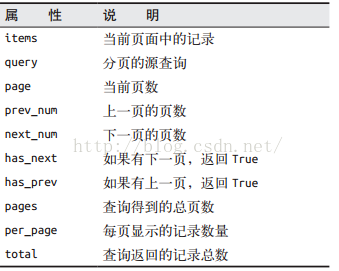Flask 学习 十 博客文章
提交和显示博客文章
app/models.py 文章模型
class Post(db.Model):
__tablename__ = 'posts'
id = db.Column(db.Integer, primary_key=True)
body = db.Column(db.Text)
timestamp = db.Column(db.DateTime,index=True,default=datetime.utcnow)
author_id=db.Column(db.Integer,db.ForeignKey('users.id'))
class User(UserMixin,db.Model):
posts = db.relationship('Post',backref = 'author',lazy='dynamic')
app/main/form.py 博客文章表单
class PostForm(FlaskForm):
body = TextAreaField('你在想什么?',validators=[DataRequired()])
submit = SubmitField('提交')
app/main/views.py 处理博客文章的首页路由 把以前发布的文章列表传给魔板
# 使用蓝本自定义路由
@main.route('/', methods=['get', 'post'])
def index():
form = PostForm()
# 检查用户是否有写文章的权限并检查是否可以通过验证
if current_user.can(Permission.WRITE_ARTICLES) and form.validate_on_submit():
# current_user._get_current_object() 新文章对象,内含真正的用户对象
post = Post(body = form.body.data,author=current_user._get_current_object())
db.session.add(post)
return redirect(url_for('.index'))
posts = Post.query.order_by(Post.timestamp.desc()).all()
return render_template('index.html',form=form,posts=posts)
index.html 显示博客文章首页模板
{% block page_content %}
<div class="page-header">
<h1>Hello,
{% if current_user.is_authenticated %}{{ current_user.username }}{% else %}访客{% endif %}!</h1>
</div>
<div>
{% if current_user.can(Permission.WRITE_ARTICLES) %} # 如果没有对应权限,则不会显示文章列表
{{ wtf.quick_form(form) }}
{% endif %}
</div>
{% include '_posts.html' %} # 引导局部模板
styles.css
.profile-thumbnail {
position: absolute;
}
.profile-header {
min-height: 260px;
margin-left: 280px;
}
ul.posts {
list-style-type: none;
padding: 0px;
margin: 16px 0px 0px 0px;
border-top: 1px solid #e0e0e0;
}
ul.posts li.post {
padding: 8px;
border-bottom: 1px solid #e0e0e0;
}
ul.posts li.post:hover {
background-color: #f0f0f0;
}
div.post-date {
float: right;
}
div.post-author {
font-weight: bold;
}
div.post-thumbnail {
position: absolute;
}
div.post-content {
margin-left: 48px;
min-height: 48px;
}
_post.html 降被以{% include '_posts.html' %}引入
<ul class="posts">
{% for post in posts %}
<li class="post">
<div class="profile-thumbnail">
<a href="{{ url_for('.user',username=post.author.username) }}"><img class="img-rounded profile-thumbnail" src="{{ post.author.gravatar(size=40) }}"></a>
</div>
<div class="post-content">
<div class="post-date">{{ moment(post.timestamp).fromNow() }}</div>
<div class="post-author">
<a href="{{ url_for('.user',username=post.author.username) }}">{{ post.author.username }}</a>
</div>
<div class="post-body">{{ post.body }}</div>
</div>
</li>
{% endfor %}
</ul>
在资料页显示博客文章
main/views.py
@main.route('/user/<username>')
def user(username):
user = User.query.filter_by(username=username).first()
#user = User.query.filter_by(username=username).first_or_404()
if user is None:
abort(404)
posts =user.posts.order_by(Post.timestamp.desc()).all()
return render_template('user.html',user=user,posts=posts)
user.html 显示有博客文章的资料页模板
<h3>发表自 {{ user.username }}</h3>
{% include '_posts.html' %}
分页显示长博客文章列表
创建虚拟博客文章数据
pip install forgerypy
整合目录

dev.txt
-r common.txt
Forgerypy==0.1
app/models.py 生成虚拟用户和博客文章
class User(UserMixin,db.Model):
@staticmethod
def generate_fake(count = 100):
from sqlalchemy.exc import IntegrityError
from random import seed
import forgery_py seed()
for i in range(count):
u = User(email=forgery_py.internet.email_address(),
username = forgery_py.internet.user_name(True),
password = forgery_py.lorem_ipsum.word(),
confirmed=True,
name = forgery_py.name.full_name(),
location=forgery_py.address.city(),
about_me=forgery_py.lorem_ipsum.sentence(),
member_since=forgery_py.date.date(True))
db.session.add(u)
try:
db.session.commit()
# 邮箱和用户名如果随机出重复的数据,则回滚到之前的对话,并不会写入到数据库
except IntegrityError:
db.session.rollback()
class Post(db.Model):
@staticmethod
def generate_fake(count=100):
from random import seed,randint
import forgery_py seed()
user_count=User.query.count()
for i in range(count):
# 为每篇文章随机制定一个用户,offset 会跳过参数中制定的记录数量,设定一个随机的偏移值
u = User.query.offset(randint(0,user_count -1)).first()
p=Post(body=forgery_py.lorem_ipsum.sentences(randint(1,3)),
timestamp=forgery_py.date.date(True),
author=u,)
db.session.add(p)
db.session.commit()
manage.py 绑定post类
from app.models import User,Role,Post def make_shell_context():
return dict(app=app, db=db, User=User, Role=Role,Post=Post)
生成虚拟用户和文章
python manage.py shell User.generate_fake(100)
Post.generate_fake(100)
在页面只渲染数据
app/main/views.py 分页显示博客文章列表
@main.route('/', methods=['get', 'post'])
def index():
form = PostForm()
# 检查用户是否有写文章的权限并检查是否可以通过验证
if current_user.can(Permission.WRITE_ARTICLES) and form.validate_on_submit():
# current_user._get_current_object() 新文章对象,内含真正的用户对象
post = Post(body = form.body.data,author=current_user._get_current_object())
db.session.add(post)
return redirect(url_for('.index'))
#posts = Post.query.order_by(Post.timestamp.desc()).all()
# 分页显示博客文章列表
# 页数请求从查询字符串中获取,如果没有制定默认为第一页
page = request.args.get('page',1,type=int)
# 显示分页需要用到sqlachemy提供的paginate方法
pagination=Post.query.order_by(Post.timestamp.desc()).paginate(page,per_page=current_app.config['FLASKY_POSTS_PER_PAGE'],error_out=False)
# 显示当前页面的记录
posts = pagination.items
return render_template('index.html',form=form,posts=posts,pagination=pagination)
添加分页导航
Flask-SQLAlchemy 分页对象的属性简介

Flask-SQLAlchemy 分页对象的方法简介

构建分页导航
templates/_macros.html 分页模版宏
{% macro pagination_widget(pagination,endpoint) %}
<ul class="pagination">
<li {% if not pagination.has_prev %}class="disabled" {% endif %}> # 如果当前页是第一页,则为这个链接加上不可用的属性
<a href="{% if pagination.has_prev %}{{ url_for(endpoint,page = pagination.page - 1,**kwargs) }}{% else %}#{% endif %}">
«
</a>
</li>
{% for p in pagination.iter_pages() %} # 迭代返回所有页面链接
{% if p %}
{% if p ==pagination.page %} # 当前显示的页面高亮显示
<li class="active">
<a href="{{ url_for(endpoint,page=p,**kwargs) }}">{{ p }}</a>
</li>
{% else %} # 否则正常显示
<li>
<a href="{{ url_for(endpoint,page=p,**kwargs) }}">{{ p }}</a>
</li>
{% endif %}
{% else %} # 中间间隔用省略号表示
<li class="disabled"><a href="#">…</a></li>
{% endif %}
{% endfor %}
<li {% if not pagination.has_next %}class="disabled" {% endif %}>
<a href="{% if pagination.has_next %}{{ url_for(endpoint,page = pagination.page + 1,**kwargs) }}{% else %}#{% endif %}">
»
</a>
</li>
</ul>
{% endmacro %}
app/templates/index.html 在博客文章列表下面添加分页导航
{% extends 'base.html' %}
{% import 'bootstrap/wtf.html' as wtf %}
{% import '_macros.html' as macros %}
。。。
<div class="pagination">
{{ macros.pagination_widget(pagination,'.index') }}
</div>
使用Markdown和Flask-PageDown支持富文本文章
Pagedown:使用JavaScript实现的客户端Markdown到Html的转换程序
Flask-PageDown: 为Flask包装的Pagedown 把Pagedown集成到Form表单中
Markdown: 使用python实现的从服务器端的MarkDOWN到HTML的转换程序
Bleach:使用python实现的HTML清理器
pip install flask-pagedown markdown bleach
使用flask-pagedown
app/__init__.py 初始化flask-pagedown
from flask_pagedown import PageDown pagedown = PageDown() pagedown.init_app(app)
flask-pagedown 扩展定义的PageDownField类和WTForm中的TextAreaField接口一致
把多行文本空间转换成Markdown富文本编辑器,需要修改body字段
app/main/forms.py 启用markdown的文章表单
from flask_pagedown.fields import PageDownField class PostForm(FlaskForm):
body = PageDownField('你在想什么?',validators=[DataRequired()])
submit = SubmitField('提交')
markdown的预览生成直接调用flask-pagedown提供的模板宏即可
app/index.html flask-pagedown 模板声明
{% block scripts %}
{{ super() }}
{{ pagedown.include_pagedown() }}
{% endblock %}
在服务器上处理富文本
app/models.py 在post模型中处理Markdown文本
from markdown import markdown
import bleach class Post(db.Model):
body_html =db.Column(db.Text)
@staticmethod
def on_changed_body(target,value,oldvalue,initiator):
allowed_tags=['a','abbr','acronym','b','blockquote','code','em','i','li','ol','pre','strong','ul','h1','h2','h3','p']
# 把body字段中的值渲染成HTML格式,结果保存到body_html中,clean函数删除不在名单里的标签,linkify函数把纯文本中的url转换成适当的<a>标签
target.body_html=bleach.linkify(bleach.clean(markdown(value,output_format='html'),tags=allowed_tags,strip=True)) # 把on_changed_body 注册在body字段上,用set监听程序,只要body字段更新,函数就会被调用
db.event.listen(Post.body,'set',Post.on_changed_body)
如果post.body_html字段存在,就把post.body换成post.body_html
templates/_posts.html 在模板中使用文章内容的HTML格式
<div class="post-body">
{% if post.body_html %}
{{ post.body_html | safe }}
{% else %}
{{ post.body }}
{% endif %}
</div>
博客文章固定链接
app/main/views.py 文章的固定链接
# 文章固定链接
@main.route('/post/<int:id>')
def post(id):
post=Post.query.get_or_404(id)
return render_template('post.html',post=[post])
templates/_posts.html
<div class="post-footer">
<a href="{{ url_for('.post',id=post.id) }}">
<span class="label label-default">永久链接</span>
</a>
</div>
在post.html中引入固定链接模板
{% extends "base.html" %}
{% block title %}Flasky - 文章{% endblock %}
{% block page_content %}
{% include '_posts.html' %}
{% endblock %}
博客文章编辑器
templates/edit_post.html 编辑博客文章的模板
{% extends "base.html" %}
{% import "bootstrap/wtf.html" as wtf %}
{% block title %}Flasky - 编辑文章{% endblock %}
{% block page_content %}
<div class="page-header">
<h1>编辑你的文章</h1>
</div>
<div>
{{ wtf.quick_form(form) }}
</div>
{% endblock %}
{% block scripts %}
{{ super() }}
{{ pagedown.include_pagedown() }}
{% endblock %}
app/main/views.py 编辑博客文章的路由
# 编辑博客路由
@main.route('/edit/<int:id>',methods=['get','post'])
@login_required
def edit(id):
post=Post.query.get_or_404(id)
if current_user != post.author and not current_user.can(Permission.ADMINISTER):
abort(403)
form = PostForm()
if form.validate_on_submit():
post.body=form.body.data
db.session.add(post)
flash('文章已经更新')
return redirect(url_for('.post',id=post.id))
form.body.data=post.body return render_template('edit_post.html',form=form)
templates/_posts.html 编辑博客文章的链接
<div class="post-footer">
<a href="{{ url_for('.post',id=post.id) }}">
<span class="label label-default">永久链接</span>
</a>
{% if current_user ==post.author %}
<a href="{{ url_for('.edit',id=post.id) }}"><span class="label label-primary">编辑</span></a>
{% elif current_user.is_administrator() %}
<a href="{{ url_for('.edit',id=post.id) }}">
<span class="label label-danger">编辑[管理员]</span>
</a>
{% endif %}
</div>
最新文章
- 【App测试】怎么测试启动时间?
- JQuery 概况
- Azure Automation (3) 定期将某个Azure订阅下的所有虚拟机开关机
- 《程序设计教学法--以Java程序设计为例》
- POJ1459Power Network(dinic模板)
- Visual Studio 2012 使用免费的Team Foundation Service(转载)
- 20141214--C#父类,子类
- msp430的两本书 电子版【worldsing笔记】
- poj1308 Is It A Tree?(并查集)详解
- RichtextBox去除闪烁光标
- PCM文件格式简单介绍
- jquery 中获取URL参数的方法
- Binder机制,从Java到C (4. Parcel)
- 如何得到iPhone手机的UUID
- SQL优化方法:
- [Swift]LeetCode954. 二倍数对数组 | Array of Doubled Pairs
- Linux学习第一天————了解root用户和基本的shell命令
- html input file accept 上传文件类型限制格式 MIME 类型列表
- sort方法实际应用详解---javascript中对一个对象数组按照对象某个属性进行排序
- 脱产班第五次大作业-FTP服务器